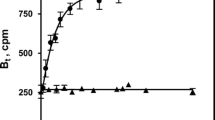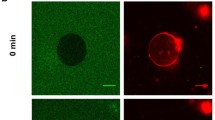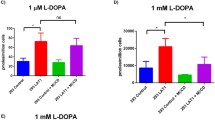Abstract
L-Dopa Decarboxylase is a pyridoxal 5-phosphate (PLP)-dependent enzyme that catalyses the decarboxylation of L-Dopa to dopamine. In this study, we investigated the cellular topology of the active human enzyme. Fractionation of membranes from human cell lines, of neural and non-neural origin, by temperature-induced phase separation in Triton X-114 resulted in the detection of DDC molecules in all separation phases. Solubilization of membrane-associated DDC was observed in a pH and time-dependent manner and was affected by divalent cations and protease inhibitors, suggesting the involvement of a possible release mechanism. The study of the biological properties and function of the solubilization phenomenon described here, as well as, the study of the membrane-associated enzyme could provide us with new information about the participation of the human L-Dopa decarboxylase in physiological and aberrant processes.








Similar content being viewed by others
Abbreviations
- DDC:
-
L-Dopa decarboxylase
- PLP:
-
Pyridoxal 5-phosphate
- HEK-293:
-
Human embryonic kidney
- SH-SY5Y:
-
Human neuroblastoma
- HTB-14:
-
Human glioblastoma, astrocytoma
- NEM:
-
N-ethylmaleimide
- SCLC:
-
Small cell lung carcinomas
- DBH:
-
Dopamine β-hydroxylase
- TH:
-
Tyrosine hydroxylase
- PNMT:
-
Phenylethanolamine N-methyl Transferase
- G-PI-anchor:
-
Glycosyl-phosphatidylinositol-anchor
- MF:
-
Membrane fraction
- APS I:
-
Autoimmune polyendocrine syndrome type I
References
Aoyagi T, Miyata S, Nanbo M et al (1969) Biological activities of leupeptins. J Antibiot Tokyo 22:558–568
Arribas J, Massague J (1995) Transforming growth factor-alpha and beta-amyloid precursor protein share a secretory mechanism. J Cell Biol 128:433–441
Batteiger B, Newhall WJT, Jones RB (1982) The use of tween 20 as a blocking agent in the immunological detection of proteins transferred to nitrocellulose membranes. J Immunol Methods 55:297–307
Baylin SB, Abeloff MD, Goodwin G et al (1980) Activities of L-dopa decarboxylase and diamine oxidase (histaminase) in human lung cancers and decarboxylase as a marker for small (oat) cell cancer in cell culture. Cancer Res 40:1990–1994
Baylin SB, Weisburger WR, Eggleston JC et al (1978) Variable content of histaminase, L-dopa decarboxylase and calcitonin in small-cell carcinoma of the lung. Biologic and clinical implications. N Engl J Med 299:105–110
Bazil V (1995) Physiological enzymatic cleavage of leukocyte membrane molecules. Immunol Today 16:135–140
Bepler G, Jaques G, Koehler A et al (1987) Markers and characteristics of human SCLC cell lines. Neuroendocrine markers, classical tumor markers, and chromosomal characteristics of permanent human small cell lung cancer cell lines. J Cancer Res Clin Oncol 113:253–259
Berry MD, Juorio AV, Li XM et al (1996) Aromatic L-amino acid decarboxylase: a neglected and misunderstood enzyme. Neurochem Res 21:1075–1087
Boomsma F, van der Hoorn FA, Schalekamp MA (1986) Determination of aromatic-L-amino acid decarboxylase in human plasma. Clin Chim Acta 159:173–183
Bordier C (1981) Phase separation of integral membrane proteins in Triton X-114 solution. J Biol Chem 256:1604–1607
Bradford MM (1976) A rapid and sensitive method for the quantitation of microgram quantities of protein utilizing the principle of protein-dye binding. Anal Biochem 72:248–254
Brown H (1977) In: Essman WB (ed) Serotonin-producing tumors. Serotonin in health and disease, vol 4. New York, pp 393–423
Buckland PR, Spurlock G, McGuffin P (1996) Amphetamine and vigabatrin down regulate aromatic L-amino acid decarboxylase mRNA levels. Brain Res Mol Brain Res 35:69–76
Chalatsa I, Nikolouzou E, Fragoulis EG et al (2011) L-Dopa decarboxylase expression profile in human cancer cells. Mol Biol Rep 38:1005–1011
Conway KA, Rochet J-C, Bieganski RM et al (2001) Kinetic stabilization of the alpha-Synuclein Protofibril by a Dopamine-alpha-Synuclein Adduct. Science 294:1346–1349
Davis Z, Moertel CG, McIlrath DC (1973) The malignant carcinoid syndrome. Surg Gynecol Obstet 137:637–644
Deutscher MP (1990) Maintaining protein stability. Methods Enzymol 182:83–89
Ehlers MR, Riordan JF (1991) Membrane proteins with soluble counterparts: role of proteolysis in the release of transmembrane proteins. Biochemistry 30:10065–10074
Erickson AH (1989) Biosynthesis of lysosomal endopeptidases. J Cell Biochem 40:31–41
Fragoulis EG, Sekeris CE (1975) Purification and characteristics of DOPA-decarboxylase from the integument of Calliphora vicina larve. Arch Biochem Biophys 168:15–25
Gazdar AF, Helman LJ, Israel MA et al (1988) Expression of neuroendocrine cell markers L-dopa decarboxylase, chromogranin A, and dense core granules in human tumors of endocrine and nonendocrine origin. Cancer Res 48:4078–4082
Gilbert J, Haber M, Bordow SB et al (1999) Use of tumor-specific gene expression for the differential diagnosis of neuroblastoma from other pediatric small round-cell malignancies. Am J Pathol 155:17–21
Gilbert JA, Bates LA, Ames MM (1995) Elevated aromatic-L-amino acid decarboxylase in human carcinoid tumors. Biochem Pharmacol 50:845–850
Gilbert JA, Frederick LM, Ames MM (2000) The aromatic-L-amino acid decarboxylase inhibitor carbidopa is selectively cytotoxic to human pulmonary carcinoid and small cell lung carcinoma cells. Clin Cancer Res 6:4365–4372
Hadjiconstantinou M, Wemlinger TA, Sylvia CP et al (1993) Aromatic L-amino acid decarboxylase activity of mouse striatum is modulated via dopamine receptors. J Neurochem 60:2175–2180
Hooper NM, Bashir A (1991) Glycosyl-phosphatidylinositol-anchored membrane proteins can be distinguished from transmembrane polypeptide-anchored proteins by differential solubilization and temperature-induced phase separation in Triton X-114. Biochem J 280(Pt 3):745–751
Houhou L, Lamouroux A, Biguet NF et al (1995) Expression of human dopamine beta-hydroxylase in mammalian cells infected by recombinant vaccinia virus. Mechanisms for membrane attachment. J Biol Chem 270:12601–12606
Husebye ES, Gebre-Medhin G, Tuomi T et al (1997) Autoantibodies against aromatic L-amino acid decarboxylase in autoimmune polyendocrine syndrome type I. J Clin Endocrinol Metab 82:147–150
Ichinose H, Kojima K, Togari A et al (1985) Simple purification of aromatic L-amino acid decarboxylase from human pheochromocytoma using high-performance liquid chromatography. Anal Biochem 150:408–414
Ichinose H, Ohye T, Fujita K et al (1994) Quantification of mRNA of tyrosine hydroxylase and aromatic L-amino acid decarboxylase in the substantia nigra in Parkinson’s disease and schizophrenia. J Neural Transm Park Dis Dement Sect 8:149–158
Kang UJ, Joh TH (1990) Deduced amino acid sequence of bovine aromatic L-amino acid decarboxylase: homology to other decarboxylases. Brain Res Mol Brain Res 8:83–87
Kelner KL, Morita K, Rossen JS et al (1986) Restricted diffusion of tyrosine hydroxylase and phenylethanolamine N-methyltransferase from digitonin-permeabilized adrenal chromaffin cells. Proc Natl Acad Sci USA 83:2998–3002
Krieger M, Coge F, Gros F et al (1991) Different mRNAs code for dopa decarboxylase in tissues of neuronal and nonneuronal origin. Proc Natl Acad Sci USA 88:2161–2165
Kuhn DM, Arthur R Jr, Yoon H et al (1990) Tyrosine hydroxylase in secretory granules from bovine adrenal medulla. Evidence for an integral membrane form. J Biol Chem 265:5780–5786
Laemmli UK (1970) Cleavage of structural proteins during the assembly of the head of bacteriophage T4. Nature 227:680–685
Lloyd K, Hornykiewicz O (1970) Parkinson’s disease: activity of L-dopa decarboxylase in discrete brain regions. Science 170:1212–1213
Lutter LC, Zeichhardt H, Kurland CG (1972) Ribosomal protein neighborhoods. I. S18 and S21 as well as S5 and S8 are neighbors. Mol Gen Genet 119:357–366
Mappouras DG, Stiakakis J, Fragoulis EG (1990) Purification and characterization of L-dopa decarboxylase from human kidney. Mol Cell Biochem 94:147–156
Morita K, Teraoka K, Oka M (1987) Interaction of cytoplasmic tyrosine hydroxylase with chromaffin granule. In vitro studies on association of soluble enzyme with granule membranes and alteration in enzyme activity. J Biol Chem 262:5654–5658
Nagatsu T, Ichinose H, Kojima K et al (1985) Aromatic L-amino acid decarboxylase activities in human lung tissues: comparison between normal lung and lung carcinomas. Biochem Med 34:52–59
Nishigaki I, Ichinose H, Tamai K et al (1988) Purification of aromatic L-amino acid decarboxylase from bovine brain with a monoclonal antibody. Biochem J 252:331–335
Park JG, Oie HK, Sugarbaker PH et al (1987) Characteristics of cell lines established from human colorectal carcinoma. Cancer Res 47:6710–6718
Poulikakos P, Vassilacopoulou D, Fragoulis EG (2001) L-DOPA decarboxylase association with membranes in mouse brain. Neurochem Res 26:479–485
Poulikakos P, Vassilacopoulou D, Fragoulis EG (2002) A membrane-associated form of L-Dopa decarboxylase in the white prepuparium and adult eclosion developmental stages of the Mediterranean fruit fly, Ceratitis capitata. Biog Amines 17:15–24
Rorsman F, Husebye ES, Winqvist O et al (1995) Aromatic-L-amino-acid decarboxylase, a pyridoxal phosphate-dependent enzyme, is a beta-cell autoantigen. Proc Natl Acad Sci USA 92:8626–8629
Rossetti Z, Krajnc D, Neff NH et al (1989) Modulation of retinal aromatic L-amino acid decarboxylase via alpha 2 adrenoceptors. J Neurochem 52:647–652
Rossetti ZL, Silvia CP, Krajnc D et al (1990) Aromatic L-amino acid decarboxylase is modulated by D1 dopamine receptors in rat retina. J Neurochem 54:787–791
Sabban EL, Greene LA, Goldstein M (1983) Mechanism of biosynthesis of soluble and membrane-bound forms of dopamine beta-hydroxylase in PC12 pheochromocytoma cells. J Biol Chem 258:7812–7818
Shirota K, Fujisawa H (1988) Purification and characterization of aromatic L-amino acid decarboxylase from rat kidney and monoclonal antibody to the enzyme. J Neurochem 51:426–434
Siaterli MZ, Vassilacopoulou D, Fragoulis EG (2003) Cloning and expression of human placental L-Dopa decarboxylase. Neurochem Res 28:797–803
Sims KL, Davis GA, Bloom FE (1973) Activities of 3, 4-dihydroxy-l-phenylalanine and 5-hydroxy-l-tryptophan decarboxylases in rat brain: assay characteristics and distribution. J Neurochem 20:449–464
Springer TA (1990) Adhesion receptors of the immune system. Nature 346:425–434
Tanaka T, Horio Y, Taketoshi M et al (1989) Molecular cloning and sequencing of a cDNA of rat dopa decarboxylase: partial amino acid homologies with other enzymes synthesizing catecholamines. Proc Natl Acad Sci USA 86:8142–8146
Towbin H, Staehelin T, Gordon J (1979) Electrophoretic transfer of proteins from polyacrylamide gels to nitrocellulose sheets: procedure and some applications. Proc Natl Acad Sci USA 76:4350–4354
Uccella S, Cerutti R, Vigetti D et al (2006) Histidine decarboxylase, DOPA decarboxylase, and vesicular monoamine transporter 2 expression in neuroendocrine tumors: immunohistochemical study and gene expression analysis. J Histochem Cytochem 54:863–875
Vachtenheim J, Novotna H (1997) Expression of the aromatic L-amino acid decarboxylase mRNA in human tumour cell lines of neuroendocrine and neuroectodermal origin. Eur J Cancer 33:2411–2417
Vassiliou AG, Fragoulis EG, Vassilacopoulou D (2009) Detection, purification and identification of an endogenous inhibitor of L-Dopa decarboxylase activity from human placenta. Neurochem Res 34:1089–1100
Vassiliou AG, Vassilacopoulou D, Fragoulis EG (2005) Purification of an endogenous inhibitor of L-Dopa decarboxylase activity from human serum. Neurochem Res 30:641–649
Voltattorni CB, Minelli A, Vecchini P et al (1979) Purification and characterization of 3, 4-dihydroxyphenylalanine decarboxyase from pig kidney. Eur J Biochem 93:181–188
Young EA, Neff NH, Hadjiconstantinou M (1993) Evidence for cyclic AMP-mediated increase of aromatic L-amino acid decarboxylase activity in the striatum and midbrain. J Neurochem 60:2331–2333
Young EA, Neff NH, Hadjiconstantinou M (1994) Phorbol ester administration transiently increases aromatic L-amino acid decarboxylase activity of the mouse striatum and midbrain. J Neurochem 63:694–697
Zhu MY, Juorio AV, Paterson IA et al (1992) Regulation of aromatic L-amino acid decarboxylase by dopamine receptors in the rat brain. J Neurochem 58:636–641
Zhu MY, Juorio AV, Paterson IA et al (1993) Regulation of striatal aromatic L-amino acid decarboxylase: effects of blockade or activation of dopamine receptors. Eur J Pharmacol 238:157–164
Aknowledgments
This work represents part of the Doctoral thesis of Ms Ioanna Chalatsa. We would like to thank Ms S. Tsiropoulou for her assistance.
Author information
Authors and Affiliations
Corresponding author
Rights and permissions
About this article
Cite this article
Chalatsa, I., Fragoulis, E.G. & Vassilacopoulou, D. Release of Membrane-Associated L-Dopa Decarboxylase from Human Cells. Neurochem Res 36, 1426–1434 (2011). https://doi.org/10.1007/s11064-011-0468-4
Accepted:
Published:
Issue Date:
DOI: https://doi.org/10.1007/s11064-011-0468-4




